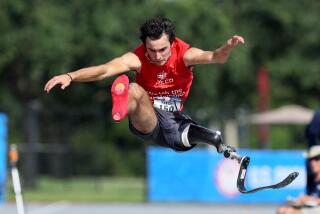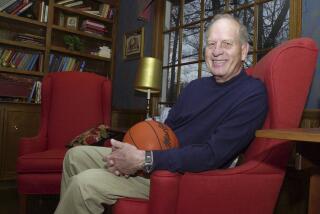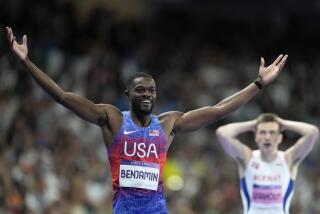For Ernie Shelton, the bar was raised just a little too high
From Cambria, Calif. — Ernie Shelton convinced himself that one day he would be celebrated in track and field circles in the same way Roger Bannister and Parry O’Brien are remembered.
Bannister, of course, was the first person to run a four-minute mile, O’Brien the first to put the shot 60 feet.
Shelton, a two-time NCAA champion at USC, believed that he would be the first to clear seven feet in the high jump. Such was his obsession that he had a crossbar mounted in his bedroom — at precisely seven feet off the floor, of course.
“I was the one,” he says, “that was supposed to do it.”
Others apparently sensed it too.
Shelton notes that after one competition, after he’d cleared 6-11, he sat with a fellow athlete who picked up a napkin. On it the man scrawled two parallel lines about an inch apart.
“You’re that far,” he told Shelton, “from immortality.”
Shelton never bridged the gap.
“I really kick myself for not doing it,” he says. “I remember a teammate telling me, ‘If you don’t make it, you’re always going to be known as the guy who didn’t make seven feet.’
“That kind of haunts me too.”
Shelton, 77, laughs nervously as he speaks. An art major at USC, he has enjoyed a long and successful career as a sculptor.
He might be proudest, he says, of the work he did for the Academy of Television Arts & Sciences headquarters in North Hollywood, where his life-sized bronze statues of Johnny Carson, Jack Benny, Lucille Ball and Desi Arnaz adorn a plaza.
“I’d watched Johnny Carson and Jack Benny for years, so I knew their mannerisms,” the easygoing Shelton says during an interview at his home and studio in Cambria, about 35 miles northwest of San Luis Obispo. “A lot of sculptors will use a generic body on somebody and do a portrait. I try to capture the whole essence of the figure and the way they walked and the way they stood.”
An eight-foot bronze of Amelia Earhart, standing outside the Amelia Earhart Branch Library in North Hollywood, also was created by Shelton, as was a refurbished statue of the late actress Myrna Loy that was unveiled last month at Venice High.
Shelton’s work also can be seen at his alma mater, where the three central figures in a statue of USC’s 1969 defensive line, a.k.a. “The Wild Bunch,” were sculpted by the former Trojans track star.
But few outside USC probably are aware that Shelton, who also created pieces that were used in “RoboCop” and numerous other films, once was the world’s top-ranked high jumper.
Using the “belly roll” jumping style, a version of the Western straddle made popular by his idol, longtime world record-holder Les Steers, Shelton won NCAA titles in 1954 and ’55.
Doggedly pursuing seven feet, the Washington High graduate put together a remarkable streak while competing worldwide, winning or tying for first in 78 consecutive outdoor finals, according to research by author Geoffrey Nelson.
Before Shelton’s senior year, former USC track coach Dean Cromwell told Sport magazine, “There’s no question but that Ernie is the greatest high jumper who ever lived.”
Shelton, though, could never reach the goal that alternately motivated and tormented him.
“It was almost like I had a hex on me,” he says. “I jumped 6-10 numerous times and 6-11 about three times. A lot of times I would try seven after making 6-10, so I had dozens of tries at it.
“Once, I was over it and the bar fell off in the wind.”
Before the 1956 U.S. Olympic trials at the Coliseum, Shelton says, Life magazine hired a hypnotist to work with him as part of a story it was preparing. Shelton, after meeting with the man at his San Fernando Valley office, dismissed him as a hustler.
The trials brought more disappointment. Bothered by a nagging leg injury, Shelton not only jumped poorly, failing to make the Olympic team, but also watched in horror on June 29, 1956, as a 19-year-old Compton College freshman named Charles Dumas became the first high jumper to clear seven feet.
“His world came crashing down upon him,” says Dick Bank, a longtime track authority who was on the Coliseum field that evening. “When Dumas cleared seven feet, Ernie broke into tears and sprinted from the field into the tunnel. . . .
“We were the closest of friends and it was really heartrending.”
Shelton never competed at that level again, jumping during a two-year Army hitch only to avoid more monotonous duty.
“It really affected me when somebody else jumped seven feet because I’d built on that for so long,” Shelton says, noting he held no grudge against Dumas, who won Olympic gold at Melbourne that year. “Even though I wasn’t jumping well at the time, it was still my goal. I’d been thinking about it since junior high.
“It was like a bursting bubble, you know? I really didn’t have any enthusiasm for jumping after that.”
Shelton’s overseas travels had exposed him to the work of great sculptors such as Auguste Rodin and Gustav Vigeland — as inspirational to him, he says, as Steers’ jumping — and after leaving the Army, he turned his full attention to sculpting.
High jumping’s loss was the art world’s gain.


